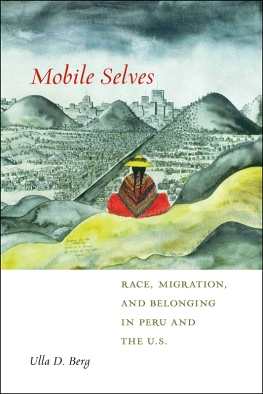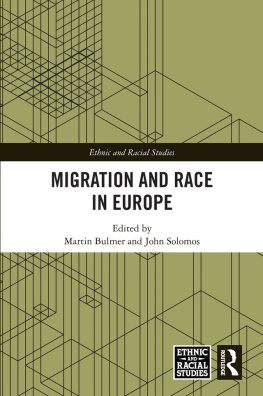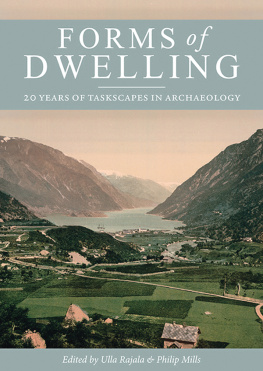NEW YORK UNIVERSITY PRESS
New York and London
www.nyupress.org
2015 by New York University
All rights reserved
References to Internet websites (URLs) were accurate at the time of writing. Neither the author nor New York University Press is responsible for URLs that may have expired or changed since the manuscript was prepared.
ISBN: 978-1-4798-0346-0
For Library of Congress Cataloging-in-Publication data, please contact the Library of Congress.
New York University Press books are printed on acid-free paper, and their binding materials are chosen for strength and durability. We strive to use environmentally responsible suppliers and materials to the greatest extent possible in publishing our books.
Manufactured in the United States of America
10 9 8 7 6 5 4 3 2 1
Also available as an ebook
Figure I.1. Map of Peru.
Figure I.2. Map of the Central Highlands.
Figure 1.1. An Internet caf (cabina pblica) in Huancayo, 2013.
Figure 1.2. A Spanish traveler mistreats his native carrier. Guamn Poma, El Primer Nueva Cornica y Buen Gobierno, 527[541].
Figure 1.3. Train arriving at Huancayo, ca. 1920.
Figure 1.4. La Carretera Central in Matahuasi, 2013.
Figure 2.1. Azngaro Antifalsification Campaign.
Figure 2.2. The U.S. embassy in Lima.
Figure 4.1. Migrant fiesta video sold in the market in Jauja, 2013.
Figure 4.2. Manuel and his family watching fiesta videos in Silver Spring, 2004.
Figure 5.1. The Peruvian Parade in Paterson, 2002.
Figure 5.2. Folklore dancers at the Peruvian Parade, 2002.
Figure C.1. A sign encouraging shopping at the new mall in Huancayo, 2011.
This book is the product of more than ten years of work thinking, reading, talking, and writing about migration and mobility and about the attachments and aspirations of people in flux. Above all else I wish to extend my deepest thanks to the many Peruvians who have contributed to this study from different latitudes and vantage points, sharing their experiences and their views, and letting me participate in their lives, travels, and daily activities over a number of years. I cannot acknowledge my interlocutors by their real names, because I promised them anonymity, but I am deeply grateful to those whose stories and experiences are reflected in this books pages. Their struggles to produce and maintain social relations while coping with the difficulties of migration and the challenges of living across many borders and boundaries continue to humble and inspire me.
The research upon which this book is based was made possible by generous funding from the Danish Research Agency, the Wenner-Gren Foundation for Anthropological Research, a McCracken Fellowship from New York University, Rutgers Research Council, and travel grants from New York University and the Center for Latin American Studies at Rutgers. Write-up of the materials was generously supported by a fellowship at the International Center for Advanced Studies (ICAS) at NYU and years later by a Richard Carley Hunt Postdoctoral Fellowship from the Wenner-Gren Foundation, which funded my academic leave from Rutgers during the last stretch of bringing the manuscript to publication.
Ambulant ethnographic work produces many debts in multiple locations. In Paterson, New Jersey, Roberto Bustamante and Luis Aranguren helped me get this project off the ground by providing important contacts and sharing a wealth of information. Manuel Angulo also endorsed my project and offered me institutional support through AIPEUC. In Miami, I am particularly indebted to the Jimnez and Alva families for spending valuable time and for sharing their everyday lives and their fiestas with me. Consul Jorge Romn and the members of the Advisory Council (Consejo de Consulta) at the Peruvian consulate in Miami provided useful testimony and perspectives on migrant-state relationships. My dear friends Fernando Calzadilla and Elaiza Irizarry offered me a lovely home away from home during fieldwork in Miami. In Washington, D.C., and Maryland, many Urcumarquinos shared their food, fiestas, and valuable time teaching me about the importance of maintaining long-distance social and affective relationships across many borders. My debt to all of them remains irredeemable.
In Peru, countless individuals and institutions have helped make this research possible. At La Catlicamy alma mater in PeruI owe much to Tefilo Altamirano, Gisela Cnepa Koch, Ral Romero, Manuel Raez, Makena Ulfe, and especially Alex Huerta-Mercado for being my unconditional interlocutor and close friend since we first met in Lima in 1997 and during our time together at NYU. I am also grateful to Martn Tanaka and Carolina Trivelli for welcoming me as an affiliated scholar at the Instituto de Estudios Peruanos (IEP) in 2004, and to Ramn Pajuelo, Javier Avila, and the late Carlos Ivn Degregori for stimulating conversations. Lucho and Renata Millones deserve special mention for their constant encouragement, cario, and continued support of my work. In Huancayo (and later Lima), my comadre and fellow anthropologist on the move, Carla Tamagno, has inspired this research in more ways than I can possibly account for. The Tamagno, Jimnez, and Caso families also facilitated my shorter and longer stays in Huancayo and in Matahuasi by putting me up in their homes, and I am grateful siempre for their hospitality and friendship. Jos Luis Alvarez first introduced me to Jauja and its surrounding communities and has been a frequent interlocutor about the history and anthropology of El Valle del Mantaro. In Lima, Carlos Cueva and Manuel Mendieta provided me with a place to live and acted as my family in Peru since my first extended stay there in 199798. My friend, the Peruvian poet Domingo de Ramos, distracted me in productive ways from writing this book and made Lima, la horrible a poetic and adventurous place to live and work. Zenaida Meza Vargas and Yobani Gonzlez Jauregui provided valuable research assistance in Huancayo and Lima, respectively, and I am grateful for their time and dedication to this project. During a brief follow-up research trip in the summer of 2011, I was fortunate to count on valuable research assistance from Alex Tavara Aranibar, Jos David Cotrina, and Jhoan Jorge Alva. Javier Avila, Rosemary Boltan, and Soledad Chacn transcribed several of my interviews.
I am indebted to several key mentors, colleagues, and friends who at different stages of my journey have been important interlocutors, pushing me toward critical analysis, and inspiring me to claim ownership over an unruly project and develop my authorial voice. Norman Long supervised my first ethnographic fieldwork and taught me much of what I know about agency and social change. His mentorship continues to influence my outlook on social science research. Karsten Paerregaard continues to be a wonderful mentor, enthusiastic colleague, academic collaborator, and dear friend. A deep gratitude goes to Thomas Abercrombie at NYU, whose complex and profound thinking on Andean lifepast and presentinspired me in ways too many to name here. From the very moment when I learned that my hat was in the ring, he believed in my project and provided me with invaluable guidance and mentorship, intellectual challenges, and enduring friendship. The guidance of Faye Ginsburg, Bambi Schieffelin, Arlene Dvila, Fred Myers, Don Kulick, Diana Taylor, and Deborah Poole have also been central to this project and I am grateful to all of them for their support.








